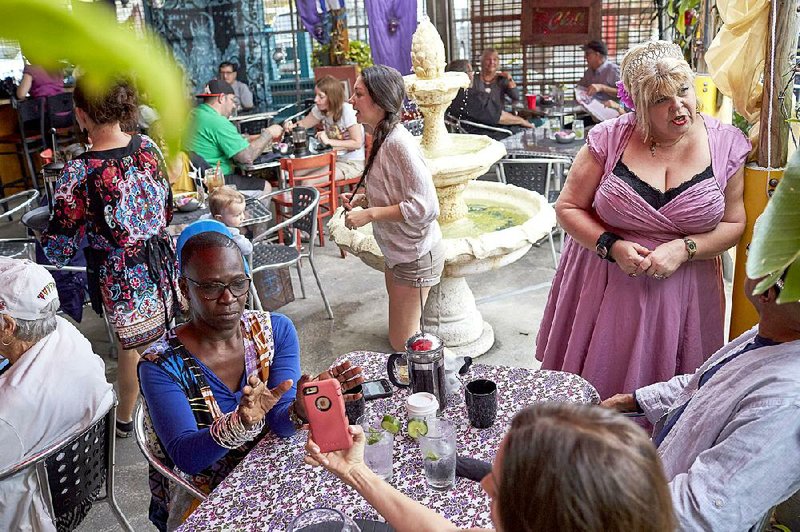The cocktail menu at Chillbar, a brunch restaurant in Hollywood, Fla., has an extensive selection of drinks incorporating vodka, rum and tequila, including the best-selling Empress Chilltini, a martini-like concoction involving elderflower, lychee, basil and a generous slug of booze. What all of Chillbar's drinks lack, though, are actual distilled spirits.
To comply with their beer-and-wine-only license, the restaurant's owners use wine-based beverages intended to mimic the taste of popular liquors. Produced and sold by Premium Blend, a small Miami company, the substitutes come in a range of strengths -- 24, 20, 17 or 14 percent alcohol -- to satisfy different states' licensing laws.
Bar and restaurant owners are used to working through a tangle of regulations, but liquor licensing may be the most Kafkaesque. Rules vary by state and county, and costs can be stratospheric, especially in areas that tightly limit the supply of licenses, usually through population-based quotas. In parts of New Jersey, among the most expensive states, the cost of a restaurant liquor license now tops $2 million.
But when markets get convoluted, entrepreneurs get creative. Around the country, restaurateurs and others in the industry are finding unusual ways to work around restrictive laws or take advantage of their loopholes.
In many places, beer and wine licenses are much less expensive and easier to obtain than those that allow hard liquor to be served. Florida law limits the supply of full-service liquor licenses, and in Broward County, where Chillbar is, they have a market value of about $150,000. Licenses to serve only beer and wine, however, are unrestricted in number and cost $392 a year.
Elizabeth Becker, Chillbar's co-owner, said that disparity made the decision easy for her restaurant. But some customers cannot face the prospect of brunch without a Bloody Mary -- and for that, she has Premium Blend's Klir Red, which promises to replicate "the clean taste of triple-distilled vodka" with a wine-based formula.
"Most people don't notice," said Becker, who incorporates Premium Blend's formulas into elaborate cocktails. "If they ask, I tell them, 'There's enough alcohol in there that you'll be fine.'"
Premium Blend, founded 26 years ago by two brothers, has a full catalog of imitation liquors sold through distributors in 39 states. The drinks are fermented, not distilled, which allows them to be legally classified as wine. They have a lower alcohol content than hard spirits, but for customers seeking a full-strength buzz, there's an easy solution: double up. Two ounces of Premium Blend's 48-proof Candian Wicket packs about the same punch as 1 ounce of a traditional 80-proof bourbon.
The company brings in about $5 million a year in sales and caters mostly to small businesses, said Henry Santos, one of the founders.
"We lose business for two reasons: They go out of business, or they grow so much that they get a full license," he said.
The imitation-liquor market is tiny, but other vendors are trickling in. Phillip Capriccio, the second-generation owner of a wholesale liquor business near Los Angeles, concocted a tequila-like agave wine a decade ago and began stocking it on his shelves. In 2011, his son Nick helped him develop a brand around it and expand the distribution.
Their company, San Gabriel Beverage Group, now also makes wine-based stand-ins for rum, gin, vodka and whiskey that are sold at a few thousand restaurants. Price is a big selling point. Most of San Gabriel's products wholesale for $7.50 to $8.50 a liter, on par with what well spirits cost.
"Our usual customers are small, mom-and-pop restaurants," Nick Capriccio said. "A lot of them are just trying to keep their lights on. It's a product that lets them compete with the full-liquor restaurant across the street."
There are other ways to stretch a license's limits. When San Francisco restaurateur Matt Semmelhack opened TBD with only a beer and wine license, he and his bar manager, Timothy Zohn, created an entire cocktail list -- they called it "the loophole menu" -- intended to exploit technicalities.
For example, the law allows bitters. So Zohn dumped an entire ounce of them into his "Nogroni," which also included juniper-infused sherry and vermouth to riff on a drink usually made with gin and Campari. (TBD closed because of a fire, but Semmelhack plans to reopen the space in the next few months as a new restaurant, Fenix, using the same license.)
"Loopholes are fun," Semmelhack said happily.
Brewery licenses are a popular workaround in other states, including New Mexico, which has given them a protectionist twist.
State-licensed small brewers are allowed to open up to three off-site taprooms. Those tasting rooms also can sell wine and beer from other craft makers, provided that the beverages are all produced in New Mexico.
"A lot of people are using these licenses to start little bars," said Kyla Rhodes Stoker, a license broker in Albuquerque. "You walk in and there's 50 beers on tap, all from New Mexico. There's a lot of creative things you can do to stay within the law."
Entrepreneurs are pushed into such contortions by the rising cost of licenses in many municipalities. The strengthening economy, and consumers' shift toward spending more on experiences like dining out than on possessions, have sent prices soaring even in once-sluggish markets.
In San Francisco, Semmelhack sometimes fantasizes about profiting from the ultimate loophole -- one that involves an actual hole.
"There's an obscure provision that if you can get from one building to another without going outside, you can use the rights of the license anywhere you can get inside," he said. AQ, his only restaurant with a full liquor license, is two doors away from the TBD space, with a coffee shop sandwiched between them.
"If we cut a hole in the walls, the coffee shop could serve booze if they want to," he said. "It's my pipe dream: Three liquor licenses for the price of one."
SundayMonday Business on 02/07/2016
